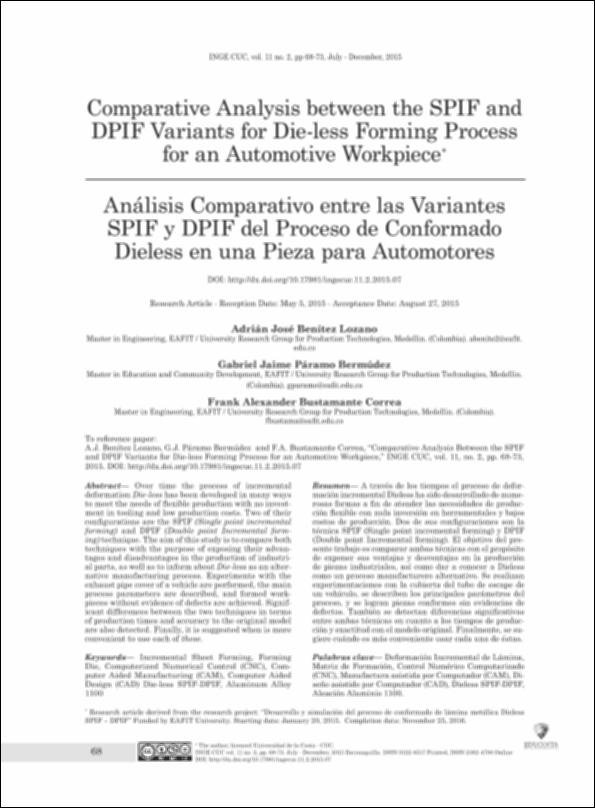Comparative analysis between the SPIF and DPIF variants for die-less forming process for an automotive workpiece
Artículo de revista
2015-09-28
Corporación Universidad de la Costa
INGE CUC
11
2
0122-6517
2382-4700
Over time the process of incremental deformationDie-less has been developed in many ways to meet the needs of flexible production with no invest-ment in tooling and low production costs. Two of their configurations are the SPIF (Single point incremental forming) and DPIF (Double point Incremental form-ing) technique. The aim of this study is to compare both techniques with the purpose of exposing their advan-tages and disadvantages in the production of industri-al parts, as well as to inform about Die-less as an alter-native manufacturing process. Experiments with the exhaust pipe cover of a vehicle are performed, the main process parameters are described, and formed work-pieces without evidence of defects are achieved. Signif-icant differences between the two techniques in terms of production times and accuracy to the original model are also detected. Finally, it is suggested when is more convenient to use each of these. A través de los tiempos el proceso de deformación incremental Dieless ha sido desarrollado de numerosas formas a fin de atender las necesidades de producción flexible con nula inversión en herramentales y bajos costos de producción. Dos de sus configuraciones son la técnica SPIF (Single point incremental forming) y DPIF (Double point Incremental forming). El objetivo del presente trabajo es comparar ambas técnicas con el propósito de exponer sus ventajas y desventajas en la producción de piezas industriales, así como dar a conocer a Dieless como un proceso manufacturero alternativo. Se realizan experimentaciones con la cubierta del tubo de escape de un vehículo, se describen los principales parámetros del proceso, y se logran piezas conformes sin evidencias de defectos. También se detectan diferencias significativas entre ambas técnicas en cuanto a los tiempos de producción y exactitud con el modelo original. Finalmente, se sugiere cuándo es más conveniente usar cada una de éstas
- Revistas Científicas [1682]
Descripción:
Comparative Analysis between the SPIF and DPIF Variants for Die-less Forming Process for an Automotive Workpiece.pdf
Título: Comparative Analysis between the SPIF and DPIF Variants for Die-less Forming Process for an Automotive Workpiece.pdf
Tamaño: 1.060Mb
 PDF
PDF
 LEER EN FLIP
LEER EN FLIP
Título: Comparative Analysis between the SPIF and DPIF Variants for Die-less Forming Process for an Automotive Workpiece.pdf
Tamaño: 1.060Mb
 PDF
PDF
 LEER EN FLIP
LEER EN FLIP








